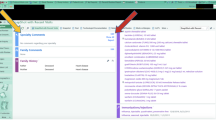Abstract
The objective of the study was to investigate the clinical effects of CT key image notes (KIN) in the interpretation of a CT image study. All experiments were approved by the ethics committee of the local district. Six experienced radiologists were equally divided into routine reporting (RR) group and KIN reporting (KIN) group. CT scans of each 100 consecutive cases before and after using KIN technique were randomly selected, and the reports were made by group RR and KIN, respectively. All the reports were again reviewed 3 months later by both groups. All the results with using or not using KIN were interpreted and reinterpreted after 3 months by six clinicians, who were experienced in picture archiving and communication system (PACS) applications and were equally divided into the clinical routine report group and the clinical KIN report group, respectively. The results were statistically analyzed; the time used in making a report, the re-reading time 3 months later, and the consistency of imaging interpretation were determined and compared between groups. After using KIN technique, the time used in making a report was significantly increased (8.77 ± 5.27 vs. 10.53 ± 5.71 min, P < 0.05), the re-reading time was decreased (5.23 ± 2.54 vs. 4.99 ± 1.70 min, P < 0.05), the clinical interpretation and reinterpretation time after 3 months were decreased, and the consistency of the interpretation, reinterpretation between different doctors in different time was markedly improved (P < 0.01). CT report with KIN technique in PACS can significantly improve the consistency of the interpretation and efficiency in routine clinical work.





Similar content being viewed by others
Abbreviations
- KIN:
-
Key image notes
- EMIF:
-
Epub of medical imaging film
- RR:
-
Routine report
- KINR:
-
Key image notes report
- CRR:
-
Clinical routine report
- CKINR:
-
Clinical Key image notes report
References
Reiner B, Siegel E: Radiology reporting: returning to our image-centric roots. AJR 187(11):1151–1155, 2006
Reiner BI, Knight N, Siegel EL: Radiology reporting, past, present, and future: the radiologist's perspective. J Am Coll Radiol. 4(5):313–319, 2007
Hagland M: The future of imaging, part II. IT leaders discuss the need to create “meta-level” software as imaging management moves outside radiology. Healthc Inform. 25(13):33–35, 2009
RSNA & HIMSS. IHE Technical Framework, Revision 6.0. http://www.rsna.org/IHE
Berlin L: Replacing traditional text radiology reports with image-centric reports: a shift from epiphany to enigma? AJR 187(5):1156–1159, 2006
Weatherburn GC, Ridout D, Strickland NH, et al: A comparison of conventional film, CR hard copy and PACS soft copy images of the chest: analyses of ROC curves and inter-observer agreement. Eur J Radiol. 47(3):206–214, 2003
Stanley RJ: What does “good medicine” mean? AJR 187(11):1145, 2006
Cohen MD: Making preliminary radiographic reports available to referring clinicians: current status. Acad Radiol. 15(1):127–131, 2008
Plumb AA, Grieve FM, Khan SH: Survey of hospital clinicians' preferences regarding the format of radiology reports. Clin Radiol 64(4):386–394, 2009. 395–396
Hurlen P, Østbye T, Borthne A, et al: Do clinicians read our reports? Integrating the radiology information system with the electronic patient record: experiences from the first 2 years. Eur Radiol. 19(1):31–36, 2009
Branstetter 4th, BF: Basics of imaging informatics-Part 1. Radiology. 243(3):656–667, 2007
Branstetter 4th, BF: Basics of imaging informatics-Part 2. Radiology. 244(1):78–84, 2007
Acknowledgments
In addition to the authors, the following investigators participated in the study: Li Li, Medical College of Southeast University; Haixiao Chen, MD; Chengcu Zhu, MD; Jian-rong Ding; Jinbiao Huang; Haitao Lin; Kun Cao, MD, Taizhou Hospital; Wei Chen, MD; Wuqiang Cao, MD; Ming Li, MD, Zhejiang RADiology Information Technology Co. Ltd.; Saofa Ke, MD; Yuanlin Zhou; Bin Wang; Peiyang Hu; Wenbin Ji, MD; Dongnv Wang, MD; Caizheng Geng, Taizhou Hospital; Yi Zhang, MD, Zhongda Hospital; Zhaojun Chen; Bang wen Chen; Huayong Zhu, Taizhou Hospital; and Yongmin Wang, MD, Zhejiang RADiology Information technology Co. Ltd. Our study is also supported by the Science Committee of Taizhou City.
Author information
Authors and Affiliations
Corresponding author
Additional information
Supported by Zhejiang Science and Technology bureau major international R&D cooperation funded projects (no. 2009C14035), Taizhou Science and Technology Program funded projects (ID 20072KY19)




